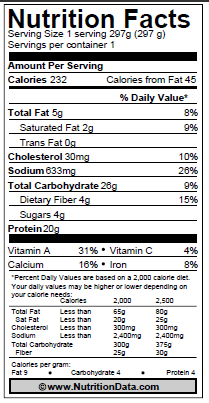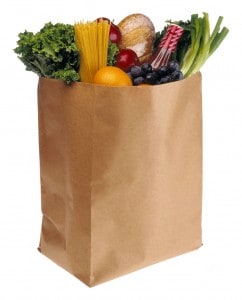 The FDA and EU consider MSG to be a harmless flavor enhancer; critics claim it’s a dangerous toxin. Who’s right? In this article, I take a look at what MSG is, how it acts in the body, how it’s used in the food supply. In Part 2 , I’ll take a closer look at charges that MSG causes headaches (“Chinese Restaurant Syndrome”), neurological damage, or has harmful effects on insulin, diabetes risk, or even obesity. Read or listen to Part 1 here.
The FDA and EU consider MSG to be a harmless flavor enhancer; critics claim it’s a dangerous toxin. Who’s right? In this article, I take a look at what MSG is, how it acts in the body, how it’s used in the food supply. In Part 2 , I’ll take a closer look at charges that MSG causes headaches (“Chinese Restaurant Syndrome”), neurological damage, or has harmful effects on insulin, diabetes risk, or even obesity. Read or listen to Part 1 here.
Tag: FDA
Can You Trust the Nutrition Facts?
 Q. How accurate are the calorie counts on nutrition facts labels? What about the nutrition information at restaurants? Is anyone checking them for accuracy?
Q. How accurate are the calorie counts on nutrition facts labels? What about the nutrition information at restaurants? Is anyone checking them for accuracy?
A. Consumers are often surprised–and dismayed–to learn that the information on nutrition facts labels is not nearly as accurate or reliable as they imagined. Part of this is built into the system. The FDA allows manufacturers and packagers a surprisingly wide margin of error–the information can be off by 20% in either direction and still be in compliance. For example, if the nutrition facts label says that a food contains 300 calories, it may actually contain anywhere from 240 to 360 calories.
This Week’s Podcast | Did the FDA Make the Right Call on Food Dyes?
 Last week, the FDA decided that there wasn’t enough evidence to warrant a ban–or even a warning–on artificial food dyes. In this week’s podcast, I have advice for parents who want to avoid them anyway, as well as a closer look at the studies that the FDA reviewed. Read or listen to it here.
Last week, the FDA decided that there wasn’t enough evidence to warrant a ban–or even a warning–on artificial food dyes. In this week’s podcast, I have advice for parents who want to avoid them anyway, as well as a closer look at the studies that the FDA reviewed. Read or listen to it here.
How safe is imported food?
 I was just reading a very interesting article on the safety of imported foods. Unfortunately, the publication (ADA Times) is for members of the American Dietetic Association so I can’t post a link for you. But here are a few nuggets you might like to know (with thanks to managing editor Liz Spittler, who researched and wrote the article).
I was just reading a very interesting article on the safety of imported foods. Unfortunately, the publication (ADA Times) is for members of the American Dietetic Association so I can’t post a link for you. But here are a few nuggets you might like to know (with thanks to managing editor Liz Spittler, who researched and wrote the article).
Nearly 1/5 of the overall American food supply (and 80% of the seafood we eat) is imported. This represents a massive increase. While inspectors used to handle a million “entry reviews” a year, the number now approaches 25 million. In response, the FDA is modernizing its oversight systems, including a new computerized screening process that helps inspectors zero in on the imports that are most likely to be a problem. The FDA has also opened offices in five countries overseas in order to increase oversight and American food safety experts are training foreign food processors on the latest food safety techniques.
How safe is imported fish?
 Q. Is imported frozen fish from countries like India and Vietnam safe? I avoid buying any food imported from China but I bought frozen Swai Basa Fish (farmed) from Vietnam and frozen Squid (caught wild) from India. They tasted really good and they were cheap, but I’m wondering if we can trust those imports or they may be full of some toxic stuff.
Q. Is imported frozen fish from countries like India and Vietnam safe? I avoid buying any food imported from China but I bought frozen Swai Basa Fish (farmed) from Vietnam and frozen Squid (caught wild) from India. They tasted really good and they were cheap, but I’m wondering if we can trust those imports or they may be full of some toxic stuff.
A. Theoretically, the safety of fish being sold in U.S. markets is monitored by federal agencies such as the FDA, whose job it is to be sure that the fish sold for human consumption in the U.S is “safe, wholesome, and not misbranded or deceptively packaged.” (Institute of Medicine on Seafood Safety)
But as we’ve seen lately, the ability of the FDA to effectively police the food supply and enforce its regulations is in serious doubt. Just a few years ago, for example, there was a scandal in which salmon being sold for a premium as “wild-caught” in both wholesale and retail markets turned out to be cheap farmed salmon. ( Story from New York Times)
To make things even more challenging, fishing and farming practices are changing rapidly around the globe as demand for seafood increases. New restrictions and best practices are being implemented. But loopholes and work-arounds are also constantly being discovered and exploited. It’s a moving target!
The best resource I’ve found to keep up with these issues is Seafood Watch. These guys are working hard to stay on top of all of these issues and to provide up-to-date resources for consumers trying to make safe and responsible choices.
I scanned Seafood Watch’s reports on both the fish you mentioned. In terms of toxins or contaminants, I didn’t see too much to worry about with the wild-caught squid, but these comments on farmed swai basa got my attention:
“Commercial aquaculture for finfish in Viet Nam continues to use relatively low technology and many operations continue to use homemade feeds…[with] little or no management of aquaculture operations…”
The safety of these fish as food obviously depends primarily on the water they’re raised in and the food they are fed. They might be perfectly fine, but it doesn’t look as if anyone is paying too much attention.
From a sustainability perspective, which is more about the long-term health of the oceans than the safety of the food, both wild-caught squid and farmed swai basa are considered “good alternatives” but not “best choices.”
